
Fynbos is a small belt of natural shrubland or heathland vegetation located in the Western Cape and Eastern Cape provinces of South Africa. This area is predominantly coastal and mountainous, with a Mediterranean climate and rainy winters. The fynbos ecoregion is within the Mediterranean forests, woodlands, and scrub biome. In fields related to biogeography, fynbos is known for its exceptional degree of biodiversity and endemism, consisting of about 80% species of the Cape floral kingdom, where nearly 6,000 of them are endemic. This land continues to face severe human-caused threats, but due to the many economic uses of the fynbos, conservation efforts are being made to help restore it.

Erica is a genus of roughly 857 species of flowering plants in the family Ericaceae. The English common names heath and heather are shared by some closely related genera of similar appearance. The genus Calluna was formerly included in Erica – it differs in having even smaller scale-leaves, and the flower corolla consisting of separate petals. Erica is sometimes referred to as "winter heather" to distinguish it from Calluna "summer heather".

Erica jasminiflora, the jasmine heath, is an endangered species of Erica, native to South Africa.
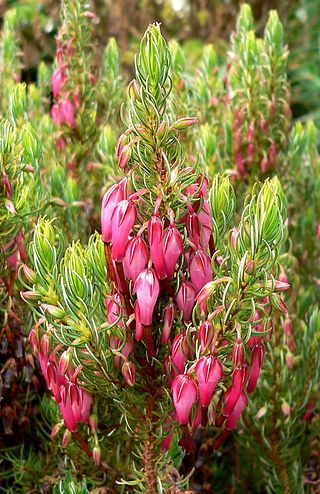
Erica plukenetii is a species of flowering plant native to the Cape region of South Africa. It belongs to the genus Erica. The species is morphologically variable, and five subspecies are recognised. The larger, variably coloured, flowers of E. plukenetii ssp. plukenetii are pollinated by sunbirds, whilst the smaller, exclusively white, flowers of E. plukenetii ssp. breviflora are moth pollinated.

Renosterveld is a term used for one of the major plant communities and vegetation types of the Cape Floristic Region which is located in southwestern and southeastern South Africa, in southernmost Africa. It is an ecoregion of the Mediterranean forests, woodlands, and scrub biome.
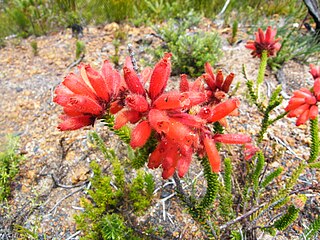
Erica cerinthoides is a species of heath native to South Africa, Lesotho and Eswatini. Common names include fire erica, fire heath, red hairy heath, rooihaartjie or klipheide. Throughout its range the species shows marked variation in habit, flower characteristics and hairiness. A form with white flowers is found in Eswatini and the South African province of Mpumalanga while the variety E. cerinthoides var. barbertona has shorter flowers.
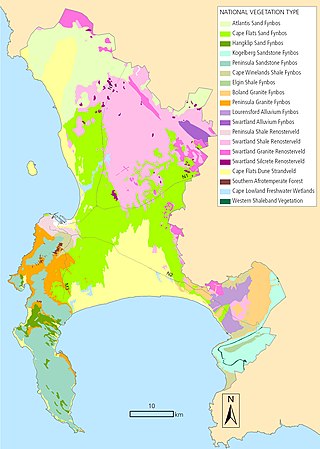
The Biodiversity of Cape Town is the variety and variability of life within the geographical extent of the City of Cape Town metropolitan municipality, excluding the Prince Edward Islands. The terrestrial vegetation is particularly diverse and much of it is endemic to the city and its vicinity. Terrestrial and freshwater animal life is heavily impacted by urban development and habitat degradation. Marine life of the waters immediately adjacent to the city along the Cape Peninsula and in False Bay is also diverse, and while also impacted by human activity, the habitats are relatively intact.

Cape Flats Sand Fynbos (CFSF), previously known as Sand Plain Fynbos, is a critically endangered vegetation type that occurs only within the city of Cape Town. Less than 1% of this unique lowland fynbos vegetation is conserved.

Cape Winelands Shale Fynbos is a vegetation type that naturally occurs in the Cape Winelands of the Western Cape, South Africa.
Mamre Nature Garden is a 254-hectare (630-acre) nature reserve in Cape Town, South Africa, located on the city's northern outskirts. The reserve has a high degree of biodiversity and preserving the endangered Atlantis Sand Fynbos vegetation type and the plants and animals that live in it. In addition, the reserve has an important cultural history.

Kenilworth Racecourse Conservation Area is a 52-hectare (130-acre) nature reserve, situated in the centre of Kenilworth Racecourse, in Cape Town, South Africa. Due to its location, it has been left undisturbed for more than 100 years, making it now the best preserved patch of “Cape Flats Sand Fynbos” in the world.
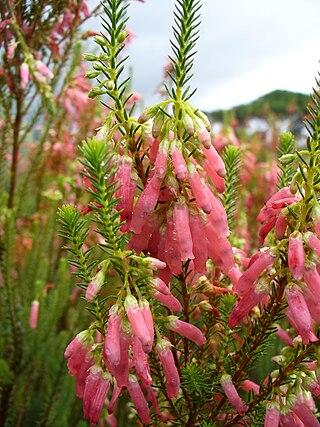
Erica mammosa, the nine-pin heath, is a species of flowering plant in the family Ericaceae, that is naturally restricted to the southwestern corner of the Western Cape, South Africa.

Erica abietina is a species of erica that is endemic to the Cape Peninsula of the Western Cape, South Africa. E. abietina includes four subspecies with often highly restricted distributions and distinctive flower colours. Previous delimitation of the species has included a further three subspecies which proved to be more distantly related to Cape Peninsula endemic E. abietina subspecies and are now classified under Erica grandiflora L.f. and Erica situshiemalis E.G.H.Oliv. & Pirie.
Erica Park, sometimes also referred to as Erica Park Stadium, is a multi-use stadium, situated in the Belhar suburb of Cape Town, at the Western Cape Province in South Africa. Until June 2010, the stadíum was known as the sole home venue of Ikapa Sporting, but since then, the club -for unknown reasons- preferred instead to play their home games in the Wynberg suburb.
Madhuca hirtiflora is a plant in the family Sapotaceae. The specific epithet hirtiflora means "hairy flowers".
Erica cabernetea is a plant species endemic to a small region in the Western Cape Province of South Africa.

Kunzea micrantha is a flowering plant in the myrtle family, Myrtaceae and is endemic to the south west of Western Australia. It blooms between September and December producing pink-purple to white-cream flowers. A widespread and variable species, it is difficult to distinguish from K. praestans and from K. micromera where their range overlap.
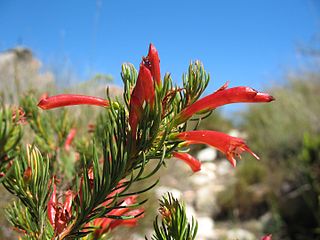
Erica grandiflora is a species of Erica found in fynbos on the mainland Western Cape, South Africa. E. grandiflora was described by Carl Linnaeus the Younger in 1782, and was reclassified as Erica abietina subsp. aurantiaca by Oliver & Oliver in 2002. More recently, phylogenetic analyses of DNA sequence data have revealed that it is more closely related to mainland Western Cape species including Erica viscaria than it is to Cape Peninsula endemic Erica abietina subspecies, and should therefore be treated as a separate species. It includes two subspecies which can be most easily distinguished on the basis of their distinctive flower colours.
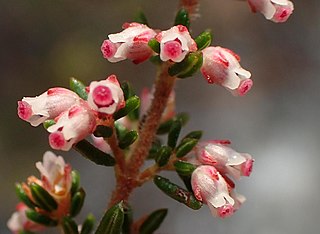
Erica peltata is a species of Erica heath endemic to the fynbos region of the Western Cape Province, South Africa.

Erica caffra is a small tree, sometimes a shrub, that grows in riparian habitats and on forest edges and occurs from the Western Cape to the Drakensberg of KwaZulu-Natal and Lesotho. The tree's flowers look like bells. The tree's national tree number is 572.
















